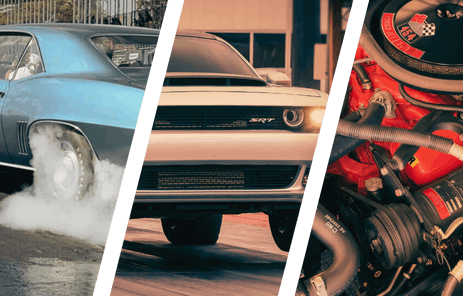
Words and Photos By: Richard Holdener
As one of the three major power producers along with the cam and intake, cylinder heads are a critical element in the success of a build-up. By now, we know high-flow, CNC-ported heads work best on large-displacement or high-rpm applications. Smaller, milder combinations simply can’t take full advantage of the airflow potential offered by the larger port volumes. The reverse is true of stock or small-port, as-cast heads, as they have no place on race applications and are much better suited to stock or mild, small-displacement combinations. Using this information, it seems we know how to select heads for our 427 stroker, race motors and for the mild, 302 street applications, but what about the middle man? What about all those 331, 347, or 392-inch strokers out there, to say nothing of hopped-up, stock-displacement (or overbore) 351 Windsors? Given the popularity of these 302 and 351W-based combinations, we decided to run a test to find suitable heads for these middle men.
To find out what middle men really wanted, we needed to first establish our middle-man test motor, then supply it with at least two different sets of heads to see some general trends. Finding the stroker motor was simple enough, as we simply dusted off the old SHP 363 stroker supplied by Dart.
The Dart stroker was essentially a bored and stroked 302, but one with much stouter components. The 363 SHP featured a Dart 4.125-inch, four-bolt block combined with a forged internals that included a 3.40-inch crank, 5.40-inch rods, and Mahle flat-top pistons. The SHP short block combined a 4.125-inch bore with the 3.40-inch stroke to achieve the 363c.i. displacement. To take full advantage of the available head flow, the 11.0:1 short block was stuffed with a solid roller cam from Cam Research Corp. The cam offered .692 lift (both intake and exhaust), a 256/260-degree duration split (at .050), and a super-tight, 105-degree lobe separation angle. The Cam Research Corp cam was combined with solid roller lifters, a double roller timing chain, and chromoly pushrods, all from COMP Cams.
In addition to the SHP short block, Dart also supplied two sets of heads (170cc and 210cc) for the test. As the name implies, the 170cc, as-cast heads featured 170cc intake ports, 65cc exhaust ports, and a 1.94/1.60 valve combination. As expected, the 170cc intake ports offered considerably less flow than the larger 210cc ports. The peak flow offered by the 170cc heads checked in at 261 cfm (intake) and 172 cfm (exhaust). By contrast, the CNC-ported, 210cc Dart Pro 1 heads offered a 2.05/1.60-inch valve combination, and peak flow numbers of 305 cfm (intake) and 208 cfm (exhaust). To equalize the static compression ratio during testing, both of the test heads featured the same 62cc combustion chambers.
Both the 170 and 210 Dart heads were installed onto the 363 stroker using Fel Pro MLS head gaskets and ½-inch ARP head studs. The heads were fed by a single-plane, Parker Funnel Web intake from Speedmaster and a 950 XP Holley carburetor. A big shout out to the Carb Shop boys for loaning us their dyno headers with Dart exhaust bolt flanges.
There was some minor housekeeping prior to running the heads on the 363 stroker. Each of the heads received a solid-roller valve-spring package, the proper pushrod length, and 1.6-ratio, aluminum roller rockers, all from COMP Cams. Naturally, we kept the air/fuel (12.8:1) and timing (35-degrees) consistent with both heads.

Though you might expect the smaller 170cc head to offer improved low-speed power (which it might at part throttle), the full-throttle power curves indicate that the 210 head was clearly the better choice. Except for a small range from 4,100 rpm to 4,800 rpm, the 210cc head offered better power everywhere, even down at 3,000 rpm. Measured peak to peak, the bigger heads improved the power output by 56 hp and 12 lb-ft of torque. Obviously, the 363 took full advantage of the extra flow offered by the CNC-ported 210 heads.
Equipped with the 170cc heads, the 363 stroke produced 510 hp at 6,500 rpm and 472 lb-ft of torque at 5,100 rpm. These were impressive power numbers given the 261 cfm offered by the 170cc intake ports. After installation of the Dart 210 Pro 1 heads, the peak numbers jumped to 566 hp at 6,800 rpm and 484 lb-ft of torque at 5,200 rpm. Obviously, the 363 stroker was stout enough to take advantage of the extra airflow offered by the CNC-ported heads, as the head swap netted 56 hp and 12 lb-ft of torque on an already impressive package.
Not many enthusiasts would complain about a stroker that produced 510 hp, but how much happier would they all be with 566 hp? Where does this test leave our middle man? To make lots of power, you better have plenty of head flow.
Sources: ARP, Arp-bolts.com; COMP Cams, compcams.com; Dart Machinery, dartheads.com; Holley/Hooker/NOS, holley.com; Mahle Motorsports, Us.mahle.com; Milodon, Milodon.com; MSD, Msdignition.com; Speedmaster, Speedmaster79.com
You might also like
Hurricane-Powered Ram Pickup First In The 8s!
Evans' elapsed time was an insane 8.89.3 at 149.10 mph with a 1.602 60-ft. time. You can almost hear the HEMI guys crying


